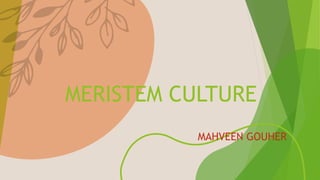
MERISTEM CULTURE / SHOOT TIP CULTURE ppt-1.pptx
- 2. MERISTEM CULTURE MERISTEMATIC TISSUE INTRODUCTION & HISTORY TECHNIQUE FACTORS AFFECTING APPLICATIONS & LIMITATIONS
- 3. Meristematic tissue All the cells of a plant embryo are capable of divisions, but with growth of plant this feature becomes restricted to only certain regions. Such embryonic regions of theoretically unlimited growth and cell divisions are referred to as meristem. Its functions include: To repair and regenerate damaged parts. Responsible for primary (elongation) and secondary (thickness) growth of a plant. Formation of new organs and their growth. 3
- 4. Introduction Meristem culture is also known as shoot tip culture. Meristem culture = meristem dome + few youngest leaf primordia. Shoot tip culture = meristem dome + primordial & developing leaves + adjacent stem tissue. Explant size: for meristem culture – 0.10 mm to 0.15 mm for shoot tip culture – 5 mm to 10 mm The primary reason for this procedure is to produce a plantlet that is free of viruses, virus like organisms, and superficial fungi and bacteria. The meristematic tip is usually free of disease organisms; therefore, the smaller the explant, the more effective the elimination of virus.
- 5. Introduction SMALLER EXPLANT SIZE ∝ 1/HIGHER THE VIRUS ELIMINATION So smaller the explant more difficult it is to establish the culture and lower the survival rate. General compromise for explant size is 0.25 mm to 1.0 mm (meristem culture). REASON FOR VIRUS-FREE MERISTEM: SAM is not connected with vascular system of plant High metabolic activity High cell division High auxin activity 5
- 6. Introduction THERMOTHERAPY (PRIOR TO EXCISION OF MERISTEM) + CHEMOTHERAPY (ANTIVIRAL CHEMICALS APPLICATION) Meristem culture is efficient for herbaceous plants. e.g.: Carnation, Chrysanthemum, Orchid, Geranium, Potato, Sweet potato, Cassava, Banana, and others. Whereas for woody plants meristem culture may not be effective so alternative procedure like micrografting can be applied. The process of meristem culture does not always free plants from viruses, therefore, claims of virus-free plants must be confirmed by virus indexing 6
- 7. History Morel and Martin (1952) were the first scientists who developed the technique for in-vivo virus eradication of Dahlia shoots. In the year 1965, Morel established the technique of meristem culture with orchids. Smith and Murashige (1970) reported the first true meristem culture of an isolated angiosperm meristem into complete plant. (true meristem = only meristem dome not the leaf primordia) Before that time, it was believed that the isolated shoot apical meristem of an angiosperm could not direct its own development but rather relied on subjacent primordial leaves and stem tissue (Ball 1946, 1960). 7
- 8. Protocol: Remove the young twigs from a healthy plant, cut the tip (1cm) portion of the twig. Subject the shoot tip to the surface sterilisation in the sodium hypochlorite solution for 10 minutes. Rinse it thoroughly with the distilled water for about 4 times. Then, transfer each explant to a sterilized Petri plate. Remove the outer leaves from each shoot tip, then the apex region will be exposed and separated using a sharp scalpel (binocular dissecting microscope can be used for dissection of true meristem or shoot tip perfectly). Meristem culture technique
- 9. Protocol: Transfer only those less than 1mm in length to the suitable nutrient medium. Flame the neck of the culture tube before and after the transfer of the excised tips. Incubate the culture under the light at 25 degrees C for 16 hours. After the development of a single or multiple shoots, transfer it to the hormone-free medium for the root development. Plantlets formed by this way are later transferred to pots containing compost and kept under greenhouse conditions. 9 Meristem culture technique
- 11. 11 Thermotherapy – growing the stock plant in warm conditions makes it strong. Explant – o Size – smaller the explant size the more effective will be the virus elimination. o Age – old plants makes it difficult to establish culture or no growth can be seen. o Time – the timing of isolation i.e., if it is in a dormant stage the culture takes longer for establishment. Sterilization – o Before inoculation - when harsh disinfectants are used for sterilization then the explant will die. o During inoculation and incubation – maintaining poor sanitation in laboratory or in growing room leads to contamination of culture which eventually blackens and then dies. Chemotherapy – treating the explant with ribavirin like antiviral chemical agents before inoculation ensures in establishing a virus free culture. Culture medium - o Cytokinin level – too much or too little cytokinin in culture makes the shoot either too long or leads to its poor multiplication or shoot too short. o Water purity – not using de-ionized water in media upsets the nutrients balance of the growth media. o Strong or wrong medium – no growth or slow growth, unwanted callus or chlorotic leaves. Incubation conditions o Temperature – growth will be too slow o pH – stage-4 plant will die Too rapid hardening – stage-4 plant will die FACTORS AFFECTING THE SUCCESS OF MERISTEM CULTURE
- 12. Agriculture – to propagate high yielding and high disease resistant crops. Horticulture – to propagate plants with desirable traits (ornamental plants and fruits). Genetic engineering – regenerating plants with desired characters such as herbicide tolerant, disease resistant and better nutritional content. Plant conservation – germplasm conservation of rare and endangered plants and germplasm exchange. Basic research – o To study the plant development o To understand the process of cell differentiation. o To research on cellular mechanisms. 12 Applications
- 13. Isolation of explant is difficult. Needs more experience. Low survival rate of culture. Regeneration time for explants is long. Removal of explant causes a setback in the growth of mother plant. 13 Limitations
- 14. 14 References websites https://www.biologydiscussion.com/ https://www.scribd.com/ https://www.slideshare.net/ Book Plant propagation by Hartmann and Kester
- 15. Thank you